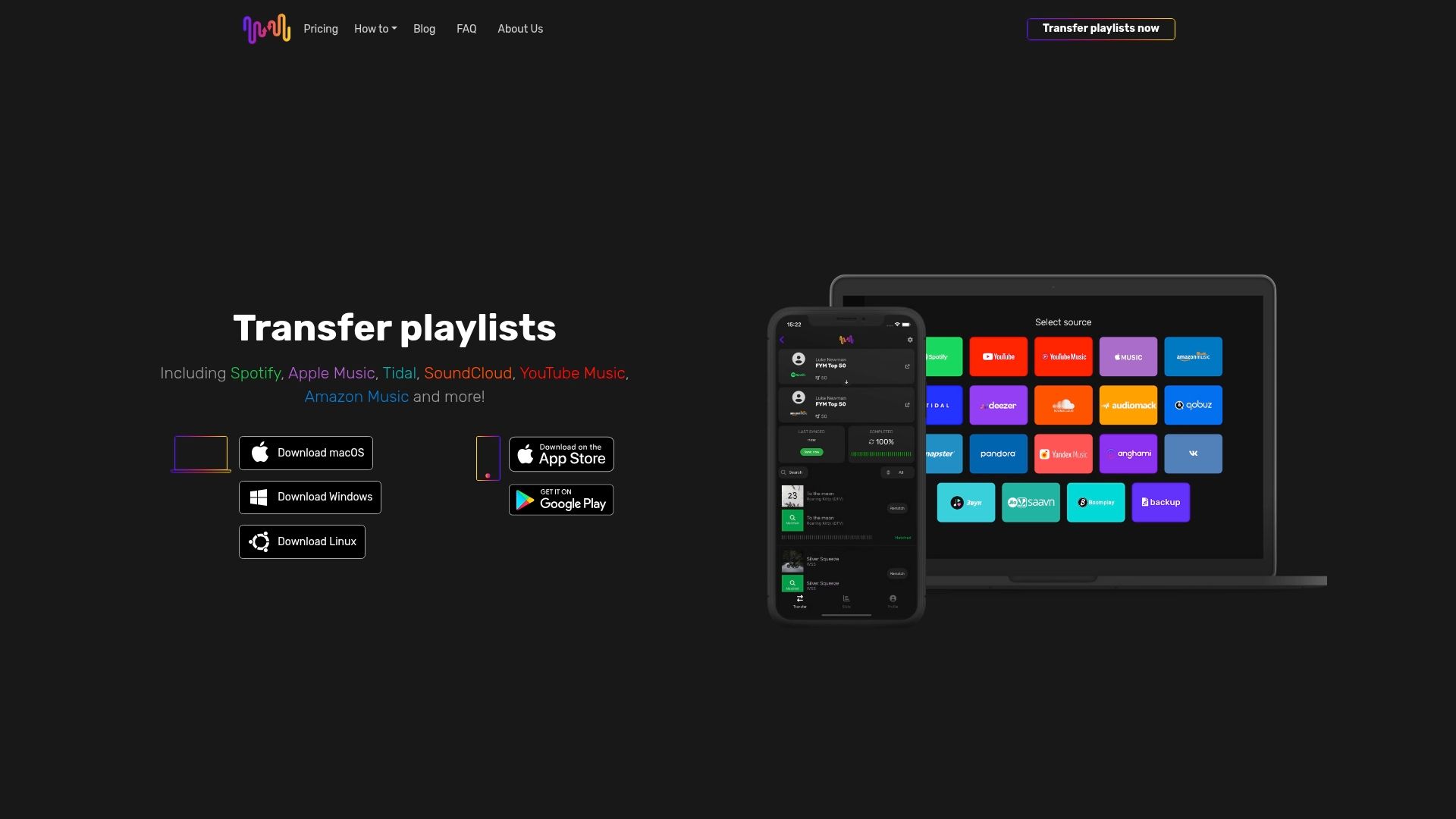Over 60% of music lovers use more than one streaming service to build their playlists and discover new favorites. With every platform offering unique features and exclusive tracks, syncing your playlists across services becomes essential yet tricky. This article explains the powerful methods behind playlist synchronization, reveals how advanced technology resolves common challenges, and helps you keep your favorite music collections updated everywhere you listen.
Table of Contents
- Defining Playlist Synchronization Methods
- Major Types of Playlist Synchronization
- How Cross-Platform Sync Works
- Key Features of Automated Playlist Sync
- Risks, Limitations, and Best Practices
Key Takeaways
| Point | Details |
|---|---|
| Synchronization Types | Playlist sync can be categorized into methods like one-directional, bi-directional, batch processing, and real-time synchronization, each with specific use cases. |
| Technological Challenges | Effective sync requires sophisticated algorithms to manage data conflicts such as duplicate tracks and differing metadata across platforms. |
| Automated Sync Advantages | Automated synchronization reduces manual effort, utilizing intelligent track matching and real-time updates for a seamless user experience. |
| Risks in Synchronization | Users must be aware of limitations like metadata inconsistencies and copyright restrictions that can affect the quality of playlist transfers. |
Defining Playlist Synchronization Methods
Playlist synchronization is a sophisticated process of managing and aligning music collections across multiple streaming platforms. According to iaeme, synchronization techniques can be categorized into several fundamental methods that determine how music libraries interact and update across different systems.
Synchronization Types emerge as critical strategies for managing digital music collections:
- One-Directional Sync: Data flows in a single direction, typically from a source playlist to a destination playlist
- Bi-Directional Sync: Allows mutual updates between two or more music platforms, enabling real-time changes across services
- Batch Processing Sync: Performs updates in scheduled intervals rather than instantaneously
- Real-Time Sync: Implements immediate changes across platforms as they occur
The complexity of synchronization becomes evident when managing data conflicts and consistency.
 As research from mdpi demonstrates, effective synchronization requires sophisticated algorithms that can handle potential discrepancies such as duplicate tracks, differing metadata, and platform-specific limitations.
As research from mdpi demonstrates, effective synchronization requires sophisticated algorithms that can handle potential discrepancies such as duplicate tracks, differing metadata, and platform-specific limitations.
Understanding these synchronization methods empowers music enthusiasts to seamlessly manage their playlists across multiple streaming services.
 Learn more about playlist transfer best practices to optimize your music management strategy and ensure your favorite tracks are always accessible, regardless of the platform.
Learn more about playlist transfer best practices to optimize your music management strategy and ensure your favorite tracks are always accessible, regardless of the platform.
Major Types of Playlist Synchronization
Playlist synchronization represents a complex ecosystem of methods designed to manage and optimize music collections across different streaming platforms. According to research from ijisae, modern synchronization techniques go beyond simple data transfer, incorporating sophisticated recommender systems and collaborative filtering to enhance music discovery and playlist management.
Primary Synchronization Approaches include:
- Manual Synchronization: Users individually transfer tracks between platforms
- Automated Synchronization: Software handles playlist transfers seamlessly
- Intelligent Synchronization: AI-powered systems that analyze and optimize playlist transfers
- Cross-Platform Synchronization: Enables transfers between completely different streaming services
The emerging landscape of playlist synchronization is rapidly evolving.
Research from arxiv highlights advanced frameworks that utilize sophisticated representation learning techniques to create more intelligent and scalable playlist continuation strategies. These methods not only transfer tracks but also understand musical context and user preferences.
Here's a comparison of primary playlist synchronization approaches:
| Synchronization Approach | Key Characteristics | Typical Use Cases |
|---|---|---|
| Manual Synchronization | User-driven transfers No automation |
Custom curation Selective moving |
| Automated Synchronization | Software-managed Saves time |
Routine updates Bulk library moves |
| Intelligent Synchronization | AI analysis Optimizes playlists |
Personalized curation Music discovery |
| Cross-Platform Synchronization | Transfers across services Handles metadata |
Multi-service libraries Eclectic collections |
Music enthusiasts can now leverage these advanced synchronization methods to create more dynamic and personalized listening experiences. Learn more about smart music sharing methods to unlock the full potential of your digital music collection and seamlessly manage your playlists across multiple platforms.
How Cross-Platform Sync Works
Cross-platform playlist synchronization is a sophisticated technological process that bridges the gaps between different music streaming services. As demonstrated by github, modern synchronization tools utilize advanced web interfaces and complex algorithms to enable seamless music library transfers across multiple platforms.
Key Components of Cross-Platform Synchronization include:
- Track Matching Algorithms: Identify equivalent tracks across different platforms
- Metadata Translation: Convert track information between streaming services
- Platform Authentication: Securely connect to multiple streaming accounts
- Track Identification: Analyze and match tracks using unique identifiers
- Playlist Reconstruction: Rebuild playlists with matched tracks
Research from arxiv reveals cutting-edge approaches to playlist synchronization, particularly highlighting the use of recurrent neural networks that can model optimal track transitions. These advanced techniques go beyond simple track transfers, creating intelligent playlist migrations that maintain the musical essence and flow of the original playlist.
The complexity of cross-platform synchronization requires sophisticated technological solutions that can navigate the unique challenges of different streaming platforms. Learn more about seamless playlist transfer methods to understand how modern technologies are revolutionizing music library management across diverse streaming ecosystems.
Key Features of Automated Playlist Sync
Automated playlist synchronization represents a groundbreaking approach to music library management, leveraging advanced algorithmic techniques to streamline music discovery and playlist curation. According to research from arxiv, modern reinforcement-learning frameworks are revolutionizing how playlists are created and synchronized across multiple platforms.
Core Features of Automated Playlist Sync:
- Intelligent Track Matching: Automatically identifies and transfers tracks across different streaming platforms
- Preference Learning: Adapts to individual user listening patterns
- Contextual Recommendation: Considers musical transitions and song sequences
- Real-Time Synchronization: Updates playlists instantly across multiple services
Research from arxiv highlights the critical importance of song context in automated playlist generation. The study reveals that successful synchronization goes beyond simple track transfer, emphasizing the nuanced understanding of musical sequence and listener preferences. Advanced algorithms now analyze previous song selections, musical genres, and listening history to create more cohesive and personalized playlist experiences.
Modern automated playlist sync tools transform how music enthusiasts manage their digital collections. Discover more about playlist management strategies to unlock the full potential of your music streaming experience and take control of your musical journey across multiple platforms.
Risks, Limitations, and Best Practices
Playlist synchronization technologies present a complex landscape of opportunities and challenges that users must carefully navigate. According to research from transactions, cross-cultural variations significantly impact playlist synchronization strategies, revealing that user expectations and engagement differ dramatically across different musical ecosystems.
Key Risks and Limitations:
- Metadata Inconsistencies: Variations in track information across platforms
- Copyright Restrictions: Legal limitations on playlist transfers
- Audio Quality Discrepancies: Potential differences in track encoding
- Algorithm Bias: Potential limitations in track matching accuracy
Research from pubmed highlights the nuanced challenges of synchronized music experiences, emphasizing that personalization algorithms must balance technical precision with user preferences. The study underscores the importance of understanding potential limitations, such as tempo mismatches and contextual inconsistencies that can disrupt the intended musical experience.
Mitigating these risks requires a strategic approach to playlist synchronization. Learn more about playlist migration best practices to ensure a smooth, reliable music transfer experience that preserves the integrity of your carefully curated playlists.
Master Your Playlist Synchronization with Ease
Managing playlists across different streaming platforms can quickly become frustrating due to inconsistent metadata, complex synchronization methods, and the challenge of preserving your music experience exactly as you want it. If you have faced issues like manual transfers, data conflicts, or limited cross-platform compatibility, you are not alone. Terms like one-directional sync, bi-directional sync, and automated playlist synchronization often sound complicated and overwhelming.
At FreeYourMusic.com, we simplify these challenges by offering a powerful platform that automates and secures playlist transfers across popular services like Spotify, Apple Music, Tidal, and more. Whether you want to preserve your playlist structure, avoid duplicate tracks, or maintain real-time synchronization, our user-friendly application handles it all while keeping your music preferences intact.

Ready to take full control of your music library and experience seamless playlist migration? Discover how FreeYourMusic.com can help you eliminate the headache of manual playlist management and enjoy uninterrupted music across all your favorite services. Start your effortless transfer journey now and explore our smart music sharing methods and seamless playlist transfer guide to unlock the true power of playlist synchronization.
Frequently Asked Questions
What are the different types of playlist synchronization methods?
Playlist synchronization methods include One-Directional Sync, Bi-Directional Sync, Batch Processing Sync, and Real-Time Sync. Each method has its unique approach to managing music collections across platforms.
How does cross-platform synchronization work?
Cross-platform synchronization involves utilizing track matching algorithms and metadata translation to facilitate the transfer of playlists between different music streaming services, ensuring that tracks are accurately identified and matched.
What are the benefits of automated playlist synchronization?
Automated playlist synchronization offers benefits such as intelligent track matching, preference learning, contextual recommendations, and real-time updates, enhancing the user experience in managing music libraries across multiple services.
What risks are associated with playlist synchronization?
Key risks include metadata inconsistencies, copyright restrictions, audio quality discrepancies, and algorithm bias, which could potentially affect the accuracy and quality of synchronized playlists.




